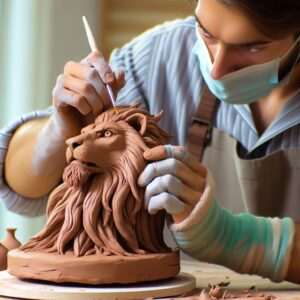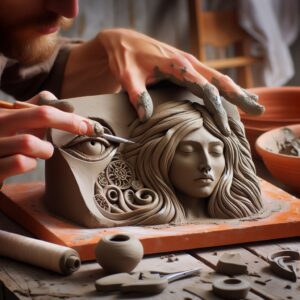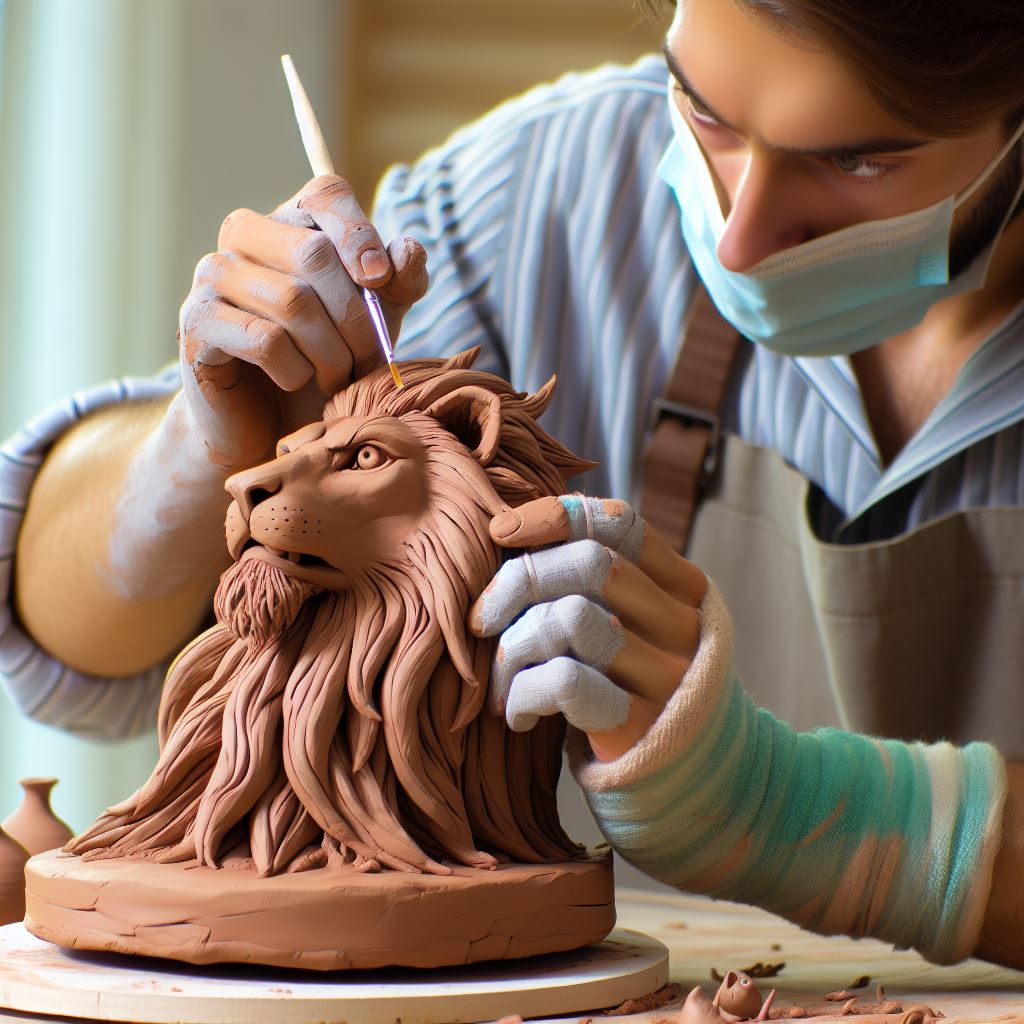Table Of Contents
- 1 Introduction to Clay Sculpting with Limited Dexterity
- 1.1 Engaging in clay sculpting, even with limited dexterity, offers several benefits:
- 1.2 Exploring the Meaning of “Clay Sculpting with Limited Dexterity”
- 1.3 Shaping Possibilities: Tools, Techniques, and Tips for Clay Sculpting with Limited Dexterity
- 1.4 Adaptive Tools:
- 1.5 Modified Techniques:
- 1.6 Helpful Tips:
- 1.7 Conclusion:
- 1.8 Key Takeaways:
- 1.9 FAQs:
- 1.9.1 1. What type of clay is best for individuals with limited dexterity?
- 1.9.2 2. Where can I find adaptive tools for clay sculpting?
- 1.9.3 3. Are there online resources or communities for clay sculpting with limited dexterity?
- 1.9.4 4. Do I need any artistic experience to try clay sculpting with limited dexterity?
- 1.9.5 5. How can I overcome challenges and frustration when sculpting with limited dexterity?
Introduction to Clay Sculpting with Limited Dexterity

Clay sculpting offers a captivating and multifaceted artistic outlet, inviting individuals of all ages and abilities to explore their creativity and find joy in the transformative power of clay. However, for individuals with limited dexterity, traditional sculpting techniques may present challenges. This session aims to provide an introduction to clay sculpting with limited dexterity, highlighting alternative methods and tools that can empower individuals to participate in this enriching art form despite physical limitations.
Engaging in clay sculpting, even with limited dexterity, offers several benefits:
- Enhanced Creativity: Exploring diverse sculpting techniques and textures stimulates the mind, fosters imagination, and encourages creative thinking outside the box.
- Improved Fine Motor Skills: Manipulating the clay, even with adaptive tools, strengthens hand and finger muscles, promoting dexterity and coordination.
- Stress Reduction: The repetitive motion of shaping and molding clay has a calming effect, promoting relaxation and reducing stress and anxiety.
- Sense of Accomplishment: Completing a clay sculpture, regardless of complexity, provides a sense of accomplishment and boosts self-confidence.
- Mindfulness and Focus: Focusing on the present moment while sculpting creates a sense of mindfulness and helps individuals stay present and focused.
- Therapeutic Benefits: Engaging in clay sculpting can be a therapeutic tool for individuals with physical limitations, offering a sense of control and accomplishment, and promoting emotional well-being.
Beyond the individual benefits, clay sculpting with limited dexterity fosters inclusivity and participation in the arts. It demonstrates that creativity and artistic expression are not limited by physical capabilities, empowering individuals to discover alternative methods and tools that allow them to express their unique artistic vision.
Exploring the Meaning of “Clay Sculpting with Limited Dexterity”

As we continue our exploration of clay sculpting with limited dexterity, let’s delve into the deeper meaning behind this unique adaptation of artistic expression. This session aims to demystify the concept and highlight the potential it holds for individuals facing physical challenges.
The term “clay sculpting with limited dexterity” refers to the practice of adapting traditional sculpting techniques and tools to accommodate the needs of individuals with physical limitations. This can involve using specialized tools, modifying existing techniques, and developing alternative approaches to shaping and manipulating clay.
It’s important to understand that “limited dexterity” encompasses a wide spectrum of physical abilities. While some individuals might require significant adaptations and assistance, others may only need slight modifications to tools or techniques to participate comfortably. Recognizing this diversity is crucial to ensure that clay sculpting remains accessible and inclusive for all.
Beyond the physical adaptations, “clay sculpting with limited dexterity” also embraces a mindset of creativity and resourcefulness. It encourages individuals to think outside the box, experiment with different tools and techniques, and find solutions that work best for their individual needs and abilities. This process fosters a sense of empowerment and self-reliance, allowing individuals to overcome physical limitations and find joy in artistic expression.
In essence, “clay sculpting with limited dexterity” challenges the notion that physical capabilities define artistic potential. It celebrates the human spirit, the power of creativity, and the transformative nature of artistic expression. It demonstrates that art is truly for everyone, regardless of physical limitations, and that even with adaptations, clay sculpting can remain a rewarding and fulfilling artistic pursuit.
Shaping Possibilities: Tools, Techniques, and Tips for Clay Sculpting with Limited Dexterity
Equipped with a deeper understanding of the meaning and benefits of clay sculpting with limited dexterity, let’s delve into the practical aspects of bringing your creative vision to life. This session will guide you through the essential adaptive tools, modified techniques, and helpful tips to overcome physical challenges and embark on your artistic journey with confidence.
Adaptive Tools:
- Large Grip Tools: Sculpting tools with larger handles and ergonomic designs provide better grip and leverage for individuals with limited hand strength or dexterity.
- One-Handed Tools: Tools designed for single-handed operation, such as rocker blades and loop tools, enable individuals with limited use of one hand to sculpt independently.
- Assistive Devices: Arms supports, headrests, and shoulder rests can provide stability and support for individuals with limited upper body mobility.
- Voice-Activated Tools: Emerging technologies like voice-controlled pottery wheels offer independence and flexibility for individuals with limited hand and arm mobility.
Modified Techniques:
- Slab Building: Rolling clay into sheets and shaping them into desired forms offers a more manageable approach for individuals with limited hand strength or dexterity.
- Coil Building: Working with pre-rolled coils of clay allows for easier shaping and manipulation compared to pinching and forming clay.
- Texture Rollers: Impressing textures onto clay surfaces using texture rollers adds visual interest and depth to sculptures without requiring complex hand movements.
- Molds and Templates: Utilizing pre-made molds and templates can simplify the sculpting process and provide structure for individuals with limited fine motor skills.
Helpful Tips:
- Start small and simple: Begin with basic projects like small bowls or pinch pots to gain confidence and master fundamental techniques.
- Work with a partner or assistant: Seek help from a friend, family member, or caregiver for tasks that require two hands or additional support.
- Experiment and adapt: Don’t be afraid to try different tools and techniques and find what works best for you.
- Focus on the process: Enjoy the tactile experience of shaping clay and focus on the creative exploration rather than striving for perfection.
- Join a community: Connect with other artists with disabilities through online forums or local workshops to share experiences, learn from each other, and find inspiration.
Beyond mastering techniques and familiarizing yourself with adaptive tools, clay sculpting with limited dexterity encourages a positive and adaptable mindset. Embrace the learning process, focus on your abilities, and don’t be afraid to ask for help when needed. The more you practice and explore, the more your creative confidence will flourish, allowing you to express yourself freely and find joy in the transformative power of clay.
Conclusion:
As we conclude our exploration of clay sculpting with limited dexterity, let’s solidify key takeaways and address frequently asked questions to empower you with the knowledge and confidence to embark on your creative journey.
Key Takeaways:
- Clay sculpting with limited dexterity offers a rewarding and enriching artistic outlet, fostering creativity, mindfulness, stress reduction, improved fine motor skills, a sense of accomplishment, and therapeutic benefits.
- Diverse adaptive tools like large grip tools, one-handed tools, assistive devices, and voice-activated tools, along with modified techniques like slab building, coil building, texture rollers, and molds and templates, empower individuals with physical limitations to participate in clay sculpting.
- A positive and adaptable mindset, coupled with a willingness to experiment, learn, and ask for help, is crucial for success in clay sculpting with limited dexterity.
- Engaging in this art form fosters inclusivity and participation in the arts, demonstrating that artistic expression transcends physical limitations.
FAQs:
1. What type of clay is best for individuals with limited dexterity?
Polymer clay and air-dry clay are generally easier to manipulate than stoneware and earthenware due to their softer texture. Additionally, consider using pre-moistened clay to reduce the need for hand strength when shaping.
2. Where can I find adaptive tools for clay sculpting?
Specialized online retailers and occupational therapy suppliers offer a variety of adaptive tools for clay sculpting. Additionally, some local art stores and pottery studios may carry a selection of adaptive tools.
3. Are there online resources or communities for clay sculpting with limited dexterity?
Several online forums and communities connect individuals with disabilities who are interested in clay sculpting. These resources offer support, inspiration, and valuable tips for adapting techniques and utilizing adaptive tools.
4. Do I need any artistic experience to try clay sculpting with limited dexterity?
No, clay sculpting is open to individuals of all skill levels. The beginner-friendly techniques and adaptive resources mentioned above make it easy to get started, regardless of prior artistic experience.
5. How can I overcome challenges and frustration when sculpting with limited dexterity?
Focus on the process of creation and enjoy the tactile experience of shaping clay. Celebrate your progress, no matter how small, and remember that everyone learns at their own pace. Don’t be afraid to ask for help and utilize the resources available to support your artistic journey.
Clay sculpting with limited dexterity offers a unique and rewarding artistic experience. By embracing its accessibility, diverse adaptive tools and techniques, and potential for self-expression, you can embark on a fulfilling journey of creativity and discovery, regardless of physical limitations. So, gather your materials, unleash your imagination, and start shaping your unique artistic vision with clay. Remember, the most important tool in clay sculpting is your own creativity. Let it guide you as you explore this captivating art form and express yourself freely through the transformative power of clay.
